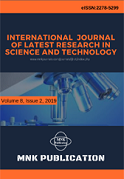DOI:10.29111/ijlrst ISRA Impact Factor:3.35, Peer-reviewed, Open-access Journal
Research Paper Open Access
International Journal of Latest Research in Science and Technology Vol.1 Issue 1, pp 25-29,Year 2012
Correspondence should be addressed to :
Received : 28 May 2012; Accepted : 20 June 2012 ; Published : 30 June 2012

| Download | 126 |
|---|---|
| View | 180 |
| Article No. | 10005 |
The gases generated in oil filled transformer can be used for determination of incipient faults. Dissolved gas analysis (DGA) of transformer oil has been one of the most power full methods to detect the faults. The various methods such as liquid chromatography, acoustic analysis, and transformer function techniques are require some experience to interpret observations. The researchers have used artificial intelligence (AI) approach to encode these diagnostic techniques. This paper presents an expert system using AI techniques which can diagnose multiple faults in a transformer theoretical and practical fuzzy-logic information model. We also concluded by identifying limitations, recent advances and promising future research directions over seventy and more power transformers.
Copyright © 2012 Hasmat Malik et al. This is an open access article distributed under the Creative Commons Attribution 4.0 International (CC BY 4.0) license which permits unrestricted use, distribution, and reproduction in any medium, provided the original work is properly cited.
              Â
Hasmat Malik, R.K. Jarial, H.M. Rai , " Fuzzy-logic Applications In Transformer Diagnosis Using Individual And Total Dissolved Key Gas Concentrations ", International Journal of Latest Research in Science and Technology . Vol. 1, Issue 1, pp 25-29 , 2012

MNK Publication was founded in 2012 to upholder revolutionary ideas that would advance the research and practice of business and management. Today, we comply with to advance fresh thinking in latest scientific fields where we think we can make a real difference and growth now also including medical and social care, education,management and engineering.

We offers several opportunities for partnership and tie-up with individual, corporate and organizational level. We are working on the open access platform. Editors, authors, readers, librarians and conference organizer can work together. We are giving open opportunities to all. Our team is always willing to work and collaborate to promote open access publication.

Our Journals provide one of the strongest International open access platform for research communities. Our conference proceeding services provide conference organizers a privileged platform for publishing extended conference papers as journal publications. It is deliberated to disseminate scientific research and to establish long term International collaborations and partnerships with academic communities and conference organizers.